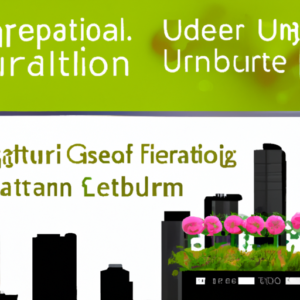
Imagine a world where bustling cities are transformed into lush green spaces, overflowing with fresh produce and vibrant flowers. This is the future of urban farming, where the concept of growing food and plants in urban environments is not only becoming a necessity but also a thriving movement. As the population continues to soar and available land diminishes, urban farming offers a sustainable solution that not only benefits the environment but also provides access to locally grown, nutritious food for city dwellers. Get ready to be inspired as we explore the exciting potential of urban farming and how it is changing the landscape of our cities.

Benefits of Urban Farming
Reduced food waste
Urban farming plays a pivotal role in reducing food waste. With traditional agriculture, a significant portion of produce ends up being discarded due to factors such as transportation delays, spoilage, and overproduction. However, urban farming allows for greater control over the production process, resulting in less food waste. By growing food in urban areas, farmers can harvest crops when they are ripe and deliver them to local consumers quickly, minimizing waste and maximizing freshness.
Improved access to fresh produce
One of the key benefits of urban farming is the improved access to fresh produce. In many urban areas, there is a lack of grocery stores or farmers’ markets, making it difficult for residents to access fresh and healthy food options. Urban farming bridges this gap by bringing agriculture directly to the city. By setting up small-scale farms in urban areas, individuals and communities can have easier access to locally grown vegetables, fruits, and herbs. This not only promotes healthier eating habits but also supports local economies.
Enhanced community engagement
Urban farming has the power to bring communities together by fostering a sense of shared purpose and responsibility. By participating in urban farming initiatives, individuals are given the opportunity to connect with their neighbors, collaborate on projects, and learn from one another. Community gardens and urban farms often become vibrant spaces where people can socialize, exchange knowledge, and build lasting relationships. This increased community engagement not only strengthens the social fabric of neighborhoods but also promotes a sense of pride and ownership among residents.
Technological Advancements in Urban Farming
Vertical farming
Vertical farming is a revolutionary farming technique that utilizes vertical space to grow crops. By stacking layers of plants on top of each other in controlled environments, vertical farms can maximize productivity within limited urban spaces. These farms often use advanced technologies such as hydroponics or aeroponics, which provide plants with the necessary nutrients and moisture without the use of soil. This innovative approach to farming allows for year-round production, reduces water usage, and eliminates the need for pesticides, ultimately increasing overall crop yields.
Aquaponics systems
Aquaponics systems combine hydroponics with aquaculture to create a sustainable and symbiotic farming method. In these systems, fish and plants coexist in a closed-loop system where the fish waste provides nutrients for the plants, and the plants filter the water for the fish. This interdependency enables urban farmers to produce both fish and vegetables in a single system, maximizing resource efficiency. Aquaponics systems require less water and land than traditional agricultural methods, making them ideal for urban environments where space is limited.
Remote sensing and automated monitoring
Technology has played a crucial role in the advancement of urban farming, particularly in the area of remote sensing and automated monitoring. Through the use of sensors, cameras, and data analytics, farmers can remotely monitor and control various aspects of their farms, such as temperature, humidity, and nutrient levels. This real-time data allows for precise adjustments to optimize crop growth and health. Additionally, automated systems can help with tasks such as irrigation, lighting, and harvesting, saving time and labor for urban farmers. These technological advancements not only improve efficiency but also contribute to the overall sustainability of urban farming practices.

Challenges in Urban Farming
Limited space
One of the main challenges in urban farming is the limited availability of space. Unlike traditional agricultural areas, cities and urban environments often have limited land suitable for farming. However, innovative farming techniques, such as vertical farming and rooftop gardens, have emerged to overcome this obstacle. By utilizing vertical space, unused rooftops, and other unconventional areas, urban farmers are able to maximize their productivity within limited areas.
High start-up costs
Another challenge faced by urban farmers is the high start-up costs associated with establishing and maintaining urban farms. The cost of land, infrastructure, specialized equipment, and technology can be significant barriers for aspiring urban farmers. However, various organizations, government grants, and crowdfunding platforms have emerged to provide financial support and resources to help individuals and communities overcome these initial costs. Additionally, as the popularity of urban farming grows, economies of scale and advancements in technology are helping to reduce the initial investment required.
Regulatory hurdles
Urban farming often faces regulatory hurdles, as it operates within the confines of city zoning and land use regulations. These regulations may limit the types of crops that can be grown, the scale of operations, and the use of certain technologies. Furthermore, navigating the complex web of permits and licenses required for urban farming can be challenging for newcomers. However, recognizing the benefits of urban farming and its potential to improve food security and sustainability, many cities and governments are adapting their regulations to be more supportive of urban agriculture. By collaborating with local authorities and advocating for policy changes, urban farmers can help create a more favorable and conducive regulatory environment.
Sustainable Practices in Urban Farming
Closed-loop systems
Closed-loop systems are an essential component of sustainable urban farming practices. These systems aim to minimize waste and resource consumption by optimizing the use of inputs and outputs. For example, aquaponics systems mentioned earlier create a closed loop where waste from fish is utilized as fertilizer for plants, while the plants filter and purify the water for the fish. Similarly, composting organic waste and utilizing it as fertilizer on-site create a sustainable nutrient cycle. By implementing closed-loop systems, urban farmers can reduce their environmental footprint and achieve a more sustainable approach to food production.
Water conservation techniques
Water conservation is a vital aspect of sustainable urban farming. In many urban areas, water scarcity is a pressing issue, making it crucial to minimize water usage in agricultural practices. Techniques such as drip irrigation, rainwater harvesting, and water-recycling systems can significantly reduce water consumption. Drip irrigation delivers water directly to the plant’s roots, minimizing evaporation and runoff. Rainwater harvesting captures precipitation for later use in watering plants. Water-recycling systems collect, filter, and reuse greywater from households or buildings for irrigation purposes. By incorporating these water conservation techniques, urban farmers can contribute to the conservation of this precious resource.
Renewable energy utilization
To further enhance the sustainability of urban farming, many farmers are turning to renewable energy sources as a means of powering their operations. Solar panels, wind turbines, and geothermal systems can provide clean, renewable energy to power lighting, heating, and cooling systems in urban farms. By relying on renewable energy, farmers can reduce their carbon footprint and decrease reliance on fossil fuels. Additionally, integrating renewable energy sources within urban farming can increase energy efficiency and resilience, ultimately supporting the transition to a more sustainable and eco-friendly agricultural system.

Integration of Urban Farms in Architecture
Green roofs and walls
Green roofs and walls are innovative ways of integrating urban farms into architecture. These features involve covering rooftops or vertical surfaces with plants, creating additional space for cultivation within urban areas. Green roofs provide numerous benefits, including improved insulation, reduced stormwater runoff, and enhanced biodiversity. They can be utilized for cultivating various types of crops, such as rooftop gardens for growing vegetables and herbs. Similarly, green walls, or living walls, provide vertical farming opportunities, making use of otherwise unused surfaces for growing plants. The integration of urban farms into architecture not only maximizes the potential for food production but also enhances the aesthetic appeal and ecological functionality of buildings.
Building-integrated agriculture
Building-integrated agriculture takes the integration of urban farms a step further by incorporating agriculture into the very structure of buildings. This approach blurs the line between architecture and farming, as entire buildings are designed to accommodate growing spaces. These buildings may be specifically constructed with features such as multilevel farms, balconies for gardening, or atriums for vertical farming. Building-integrated agriculture promotes the seamless integration of urban farming into the urban landscape, creating opportunities for sustainable food production while minimizing the need for additional agricultural land.
Urban agriculture in skyscrapers
Skyscrapers offer a unique opportunity for large-scale vertical farming in urban environments. Through innovative techniques such as hydroponics and aeroponics, crops can be grown on multiple floors of skyscrapers, maximizing the utilization of vertical space. These urban farms can benefit from natural light, artificial lighting systems, and controlled environments to optimize crop growth. Urban agriculture in skyscrapers not only provides a sustainable solution to urban food production but also contributes to the architectural and economic development of cities. In addition, the proximity of these farms to urban populations reduces transportation distances and ensures the availability of fresh produce to city dwellers.
Educational Opportunities in Urban Farming
School gardens and urban farms
Educational opportunities in urban farming are abundant, particularly in the form of school gardens and urban farms. By integrating farming into school curricula, students can gain hands-on experience in growing their own food and understanding the importance of sustainable agriculture. School gardens provide a platform for students to learn about plant biology, nutrition, and the environmental impacts of food production. Urban farms can also serve as outdoor classrooms, where students can learn about urban planning, entrepreneurship, and community engagement. These educational initiatives foster a deeper connection to nature, promote healthy eating habits, and equip future generations with the knowledge and skills needed for a sustainable future.
Workshops and training programs
Workshops and training programs are valuable educational opportunities for individuals interested in urban farming. These programs provide a platform for aspiring urban farmers to learn about various aspects of urban agriculture, ranging from technical skills to business management. Workshops may cover topics such as hydroponics, vertical farming, pest control, and urban farm design. Training programs, on the other hand, offer more comprehensive and structured learning experiences, often resulting in certifications or degrees in urban farming. These educational opportunities empower individuals with the knowledge and skills necessary to start and manage successful urban farming ventures.
Collaborations with universities
Many universities have recognized the importance of urban farming and have established programs and research centers dedicated to exploring its potential. Collaborations between urban farmers and universities can provide valuable resources, research, and expertise to support the growth of urban farming practices. Universities often conduct research on topics such as sustainable farming techniques, urban food systems, and policy advocacy. Additionally, these collaborations can give urban farmers access to university-owned land or facilities for experimentation and pilot projects. By bridging academia and practice, collaborations lay the foundation for continuous innovation and advancements in urban farming.
Employment Opportunities in Urban Farming
Farm management positions
As urban farming continues to gain popularity, employment opportunities in farm management positions are on the rise. Urban farms require skilled individuals to manage day-to-day operations, oversee crop growth, and ensure the efficient functioning of the farm. Farm managers often need a combination of agricultural knowledge, business acumen, and project management skills to succeed in these roles. Additionally, they play a crucial role in community engagement, marketing, and outreach efforts, connecting the farm to local residents and consumers. The increasing demand for locally grown food presents a promising career path for individuals passionate about sustainable agriculture and community development.
Agricultural technology specialists
With the integration of technology into urban farming practices, the demand for agricultural technology specialists is also increasing. These individuals possess a deep understanding of technological advancements in farming and are skilled in areas such as remote sensing, automated monitoring systems, and data analytics. Agricultural technology specialists play a vital role in optimizing farm operations, ensuring crop health, and developing innovative solutions to enhance productivity and sustainability. Their expertise and knowledge enable urban farmers to leverage technology to its fullest potential, ultimately driving the evolution of urban farming practices.
Sales and marketing roles
Urban farming relies on effective sales and marketing strategies to connect farmers with consumers. Sales and marketing roles in urban farming entail promoting farm products, establishing partnerships with local businesses, managing farmers’ markets or CSAs (Community Supported Agriculture), and creating consumer awareness about the benefits of locally grown food. These roles require strong communication, networking, and branding skills to attract customers and build loyalty. With the increasing demand for fresh and sustainably grown produce, sales and marketing professionals in urban farming have the opportunity to make a significant impact on local food systems and community well-being.
Impacts on Food Supply Chain
Reduction of transportation distances
One of the significant impacts of urban farming on the food supply chain is the reduction of transportation distances. Traditional agricultural practices often involve long-distance transportation of food from rural areas to urban centers. This transportation leads to increased carbon emissions, higher costs, and decreased freshness of produce. By growing food directly in urban areas, urban farming shortens the distance between production and consumption, minimizing the need for lengthy transportation routes. This reduction in transportation distances improves the overall efficiency and environmental sustainability of the food supply chain.
Shorter supply chains
Urban farming contributes to the development of shorter food supply chains. In traditional agricultural systems, food often passes through multiple intermediaries, such as distributors and retailers, before reaching the end consumer. Each step in the supply chain adds costs, potential food waste, and complexity to the process. Urban farming eliminates some of these intermediaries by allowing farmers to sell directly to consumers through farmers’ markets, CSAs, or on-site farm stands. By shortening the supply chain, urban farming enhances transparency, reduces costs, and increases traceability, ultimately providing consumers with fresher and more nutritious food options.
Increased food security
Urban farming has the potential to significantly impact food security in urban areas. With the global population expected to reach nearly 10 billion by 2050, ensuring a stable and sustainable food supply is crucial. By establishing local food production systems, urban farming reduces dependence on distant food sources and enhances the resilience of urban communities in the face of potential disruptions in the global food supply chain. Urban farming promotes self-sufficiency, increases access to fresh and nutritious food, and creates a buffer against external shocks, ultimately improving food security for urban populations.
Government Initiatives and Policy Support
Zoning laws and regulations
Government initiatives and supportive policies play a vital role in the growth and success of urban farming. Zoning laws and regulations dictate land use and often determine the feasibility of urban farming practices. Recognizing the benefits of urban farming, some cities and governments are amending zoning laws to allow for agricultural activities in urban areas. This may involve designating specific areas for urban farms, relaxing restrictions on land use, or providing incentives for the conversion of abandoned or underutilized spaces into urban farming sites. By adapting zoning laws, governments can create an enabling environment that encourages the development of urban farming initiatives.
Incentives for urban farming
To further support urban farming, governments can provide various incentives to individuals and organizations involved in urban agriculture. These incentives may include tax breaks, grants, low-interest loans, or access to affordable land or infrastructure. By offering financial support or reducing the financial burden associated with urban farming, governments can stimulate investment, foster innovation, and attract more individuals to engage in urban farming practices. Incentives create a favorable environment for the growth and sustainability of urban farming, ensuring its long-term viability as a solution to food security and sustainable agriculture.
Collaboration with local authorities
Collaboration between urban farmers and local authorities is essential for the successful implementation and growth of urban farming initiatives. By working together, farmers and local authorities can address potential challenges, such as land access, regulatory compliance, and community integration. Local authorities can provide technical expertise, resources, and support in navigating the bureaucratic processes associated with urban farming. Additionally, collaboration can lead to the development of policies, programs, and infrastructure that support urban farming on a city-wide scale. By fostering strong partnerships, urban farmers and local authorities can collectively shape the future of urban farming and maximize its potential benefits for communities.
Disruptive Potential of Urban Farming
Revolutionizing traditional agriculture
Urban farming has the potential to revolutionize traditional agriculture by challenging long-held concepts and practices. By exploring innovative techniques such as vertical farming and aquaponics, urban farming presents alternative approaches to food production that can address the limitations and shortcomings of conventional agricultural systems. The integration of technology, renewable energy, and closed-loop systems in urban farming practices pushes the boundaries of what is possible in agriculture. As the demand for locally grown, sustainable food continues to increase, urban farming serves as a catalyst for change and innovation in the broader agricultural industry.
Addressing food deserts
Food deserts, areas with limited access to affordable and nutritious food, are a significant challenge in many urban communities. Urban farming offers a solution to this problem by bringing fresh produce directly to these underserved areas. By establishing community gardens, rooftop farms, or mobile farmers’ markets, urban farming bridges the gap between food production and consumption in food deserts. This increased availability and accessibility of fresh food options contribute to improved nutrition, health outcomes, and overall well-being in these communities. Urban farming is not only about food production but also about social equity and addressing the underlying causes of food insecurity.
Alleviating pressure on rural farming
As urban populations continue to grow, the demand for food places increased pressure on rural farming communities. This pressure often leads to unsustainable agricultural practices, deforestation, and the depletion of natural resources. Urban farming can help alleviate this pressure by creating alternative food production systems within urban areas. By localizing food production, urban farming reduces the reliance on rural farmland and the associated environmental impacts. This complementary relationship between urban and rural farming can help achieve a more balanced and sustainable agricultural system, benefiting both urban and rural communities.
In conclusion, urban farming offers numerous benefits, from reducing food waste and improving access to fresh produce to enhancing community engagement. Technological advancements, such as vertical farming, aquaponics systems, and remote sensing, are revolutionizing urban farming practices. However, there are challenges to overcome, including limited space, high start-up costs, and regulatory hurdles. Sustainable practices, including closed-loop systems, water conservation techniques, and renewable energy utilization, are essential for long-term viability. Furthermore, the integration of urban farms into architecture, educational opportunities, employment prospects, and impacts on the food supply chain are significant aspects to consider. Government initiatives, policy support, and the disruptive potential of urban farming, such as revolutionizing traditional agriculture and addressing food deserts, demonstrate the transformative power of this practice. By embracing urban farming, communities can build sustainable food systems, increase food security, and enhance overall well-being.






